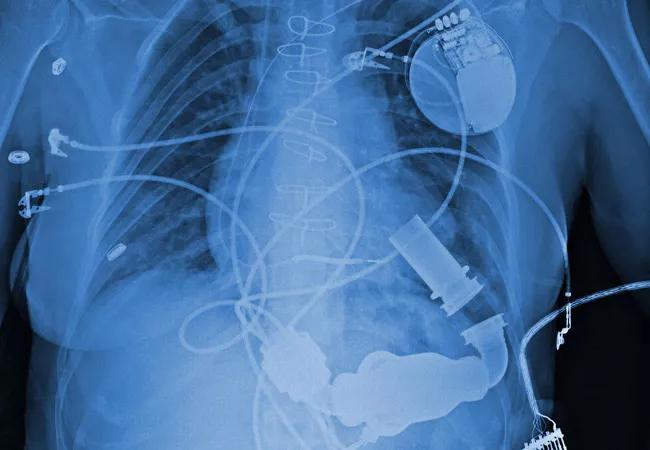First study of arrhythmia prevalence and treatment in this setting

Atrial tachyarrhythmias are common in advanced heart failure patients on left ventricular assist devices (LVADs), but aggressive treatment to regulate heart rhythms appears to convey little benefit in this setting, according to new research from Cleveland Clinic.
Cleveland Clinic is a non-profit academic medical center. Advertising on our site helps support our mission. We do not endorse non-Cleveland Clinic products or services. Policy
In a retrospective analysis involving more than 400 patients who received LVADs at Cleveland Clinic over more than a decade, 71 percent experienced atrial fibrillation (AF) and/or atrial flutter (AFL). Among these patients, rhythm control measures such as cardioversion or treatment with anti-arrhythmic drugs were not associated with improved survival or fewer blood clots or bleeding events.
The study is the first to examine the prevalence of AF and AFL and the impact of rhythm control strategies in patients on LVADs, says Cleveland Clinic electrophysiologist Daniel J. Cantillon, MD, senior author of the study, which was presented May 10 at the Heart Rhythm Society’s 39th Annual Scientific Sessions.
“Study after study has shown that in the pre-LVAD heart failure state, aggressive rhythm control treatment is associated with better outcomes in patients with atrial fibrillation,” Dr. Cantillon says.
He adds that while the general assumption has been that AF and AFL patients derive the same benefit from rhythm control therapy after they receive an LVAD, the newly research did not show this.
“It may be that once a patient has the added support of the LVAD, the contribution of the upper chambers to the heart’s performance is minimal,” he says. “We conclude that it appears there is no significant benefit to treating atrial tachyarrhythmias aggressively in this setting.”
Once reserved for heart failure patients awaiting transplantation, mechanical circulatory support with an LVAD is increasingly used as destination therapy for the long-term treatment of patients who aren’t candidates for heart transplant.
“With advances in LVAD technology, studies are now showing people living for as long as 10 years with these devices, which is remarkable,” Dr. Cantillon notes. “They have been a game changer for these very sick patients.”
Given the increasing use of LVADs as destination therapy, it’s important to understand how to best manage this growing patient population, he adds. “We want these patients to have maximal survival along with the best possible quality of life once they have their LVAD.”
The newly reported study included 420 patients (age, 54.8 ± 13.4 years; 79.3 percent male) treated with LVADs at Cleveland Clinic between January 2004 and June 2016. Median follow-up was 445 days (25th/75th quartiles, 166/935 days).
A total of 282 patients (67.1 percent) had AF, and 58 patients (13.8 percent) had AFL.
Among the main study findings:
“This is an important study that complements a growing body of evidence showing that LVADs induce not only favorable structural but also electrical remodeling,” observes Cleveland Clinic cardiothoracic surgeon Edward Soltesz, MD, MPH, whose specialty interests include LVAD implantation. “Clinically, these results should enable LVAD caregivers to tailor the medical regimens of thousands of LVAD patients with atrial arrhythmias and potentially liberate them from certain antiarrhythmic drugs.”
In addition to the original research presented at the Heart Rhythm Society meeting, Dr. Cantillon was invited to present an update on the use of implantable cardioverter-defibrillators (ICDs) in patients with LVADs.
In a study published in Heart Rhythm in 2010, Dr. Cantillon’s team was the first to show improved survival with ICD use in heart failure patients who had ventricular assist devices.
The Cleveland Clinic findings were later confirmed at other centers, and a 2016 meta-analysis of six observational studies involving more than 900 patients showed all-cause mortality at seven months among LVAD patients with ICDs to be half the mortality rate among LVAD patients without ICDs (16 vs. 32 percent; relative risk, 0.61; 95% CI, 0.46-0.82).
But Dr. Cantillon notes that while ICDs are life savers for heart failure patients with LVADs, patients also report high levels of psychological distress and disruptions in quality of life.
“Shocks from the defibrillator can be painful and upsetting,” he explains. “We are working to optimize ICD programing to give patients the lifesaving benefits of having the defibrillator while reducing unnecessary shocks.”

Surprise findings argue for caution about testosterone use in men at risk for fracture

Findings support emphasis on markers of frailty related to, but not dependent on, age
![GettyImages-1252287413 [Converted]](https://assets.clevelandclinic.org/transform/StoryPanel/350804b2-f1e4-4d97-a277-9629cf45af3e/23-HVI-4120348_redlining_650x450_jpg?w=3840&q=75)
Large database study reveals lingering health consequences of decades-old discrimination

Additional analyses of the two trials presented at 2023 ESC Congress

Prospective SPIRIT-HCM trial demonstrates broad gains over 12-month follow-up

An ACC committee issues recommendations to accelerate sluggish progress

Review of our recent experience shows it’s still a safe option

Machine learning may improve risk prediction and guide therapy